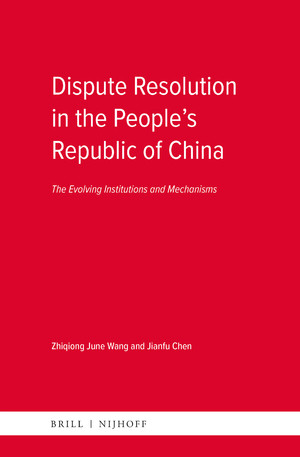Opinion by Zhiqiong June Wang

The world has witnessed significant developments in the institutions, mechanisms and processes of dispute resolution in China since the introduction of Open Up and Reform policies in 1978. Legal reforms since then have restored the court system and the legal profession. In commercial law, China’s WTO accession has further significantly facilitated the modernisation of legal institutions and the commercial law legal framework. With economic development and the strengthening of the legal system, there has also been significant growth in litigation, a development that does not sit comfortably with the traditional view in China that direct conflict should be averted and mediation or other non-confrontational means should be applied to resolve disputes. Additionally, under Xi’s leadership, China has begun to assert its own model of governance which has been presented to the world as a potential alternative global governance model.
At a practical level, ever increasing court caseloads in civil, commercial and administrative disputes have put major pressure on the court system and its resources. Indeed, according to a recent Supreme People’s Court Report, Chinese courts adjudicated some 28 million cases (of which more than half were civil and economic cases) in 2018. Not surprisingly, major reforms of dispute resolution mechanisms have been carried out in the last decade and continue until this day. In the last ten years or so, the dispute resolution system in China under Xi has been elevated to a mechanism treated as part of the new governance model, and its capacity as indicative of governance capacity.
The new system promoted by the Chinese government is described by Chinese authorities as a ‘Mechanism for Pluralist Dispute Resolution’ (PDR)(Duoyuanhua Jiufeng Jiejue Jizhi 多元化争端解决机制). The Chinese term ‘duoyuanhua’ has been variously translated as ‘multiple’ and ‘diversified’; however, in the book I co-authored with Prof Jianfu Chen, Dispute Resolution in the People’s Republic of China: The Evolving Institutions and Mechanisms, we decided after careful consideration that ‘pluralist’ is a better translation, since it indicates that the ‘duoyuanhua’ system is new and different, and the ‘multiple’ or ‘diversified’ dispute resolution methods it refers to are not just independent alternatives but interrelated components in an integrated and coordinated system.
The term ‘Mechanism for PDR’ first appeared in 2004 in the 2nd Five Year Reform Plan of the People’s Courts, and again in 2008 in the judicial reform scheme coordinated by the Communist Party of China (CPC) Central Committee on Judicial Reform. The most important policy measures, however, emerged in 2013 and 2014. The CPC Central Committee in 2014 stipulates that:
Mechanisms for prevention and resolution of social conflicts and disputes shall be strengthened, and a pluralist dispute resolution mechanism, in which mediation, arbitration, administrative ruling, administrative reconsideration, and litigation shall be organically linked and their operations be coordinated, shall be improved.
– Item 5 (4), Decision Concerning Certain Major Issues in Comprehensively Moving Forward Ruling the Country According to Law, CPC Central Committee, 2014
This 2014 CPC Decision makes the reform task clear: to develop a comprehensive dispute resolution system in which the various dispute resolution methods are not treated as separate alternatives, but as mutually supportive components in an integrated system of PDR.
In Chinese literature and policy documents the term ‘Mechanism for PDR’ has been used in both a broad and narrow context.
The 2014 CPC Decision refers to strengthening mechanisms for the prevention and resolution of social conflicts and disputes and emphasises building and improving the interconnection and coordination of all kinds of dispute resolution methods. These measures include alternative dispute resolution (ADR), litigation and administrative measures and a great variety of organisations, including the judiciary (courts and procuratorates) and many government authorities such as administrative law enforcement agencies (public security authorities) and offices of Comprehensive Control and Social Management (Zongzhi Ban 综治办), as well as mass/social organisations (Trade Unions, Women’s Federations, Youth Leagues, Neighbourhood Committees). In this broad context, the term refers to a system of mechanisms for comprehensive social control and the prevention of social conflict and instability (Weiwen 维稳) under the general umbrella of social governance, which is clearly more political than legal. These reforms aim at establishing an integrated dispute resolution system that forms part of China’s new governance model, addressing not only dispute resolution but also the prevention of social conflict and maintenance of social stability.

Conversely, the term is also used in a narrow sense, referring to an integrated system of legal mechanisms, the reform of which is led by the Supreme People’s Court, which focuses on building links between ADR, administrative review, adjudication and litigation. These include judicial confirmation of mediation agreements, support for arbitration and the enforcement of arbitral awards, appointing mediators and arbitration institutions as court-sanctioned mediators and arbitrators, establishment of ‘one-stop’ (Yizhanshi一 站式) dispute resolution mechanisms within the court system, and shared platforms for litigation and ADR.
The comprehensive approach, under the umbrella of strengthening PDR as a dispute resolution mechanism, is innovative yet full of uncertainties. It is probably well-intended that all social forces are mobilised to prevent and resolve social conflicts and disputes, and the one-stop approach may provide convenience and efficient and effective dispute resolution solutions.
It is uncertain and potentially risky, not just because the Mechanism for PDR may be used as an instrument for social control, but because this may politicise an otherwise innovative reform. On the other hand, however, efforts towards building and strengthening the PDR, in the narrow sense of the term, led by the Supreme People’s Court, are to be welcomed. These efforts have seen the strengthening and further development of mediation and arbitration, as well as the establishment of various mechanisms for ADR and litigation to work together as a ‘united force’ for dispute resolution.
Zhiqiong June Wang (PhD) is Associate Professor of Law, Western Sydney University, Australia. June’s research interests are in Chinese law, international economic law, dispute resolution and comparative law. Her China-related research focuses on original observation and analysis of the various institutional reforms in the area of commercial law in China. June is also an arbitrator of the Shenzhen International Court of Arbitration.
On this topic, June has co-authored with Professor Jianfu Chen the article ‘From Alternative Dispute Resolution to Pluralist Dispute Resolution: Towards an Integrated Dispute-Resolution Mechanism in China’ published by the International Journal of Law in Context (SSRN), and the book ‘Dispute Resolution in the People’s Republic of China: The Evolving Institutions and Mechanisms’, and ‘Will the establishment of circuit tribunals break up the circular reforms in the Chinese judiciary?‘ published by the Asian Journal of Comparative Law (SSRN).
Twitter @ZhiqiongJuneWang
